Pizza: Basic Information
Pronunciation
Alternative Name(s)
Dish Type
Course
Mealtime
Popular Variations
- Pizza Margherita
- Neapolitan Pizza
- Pizza Quattro Stagioni
- Pizza Quattro Formaggi
- Pizza Capricciosa
- Pizza Marinara
- California-style Pizza
- Colorado-style Pizza
- Chicago-style Pizza
- Detroit-style Pizza
- St. Louis–style Pizza
- New York–style Pizza
- New Haven–style pizza
- Pizzetta
- Deep-fried Pizza
- Chocolate Pizza
- Greek Pizza
- Grandma Pizza
- Happy Pizza
- Hawaiian Pizza
- Pizza Pugliese
- Kebab Pizza
- Seafood Pizza
- Taco Pizza
- Trenton Tomato Pie
- Italian Tomato Pie
- Jumbo Slice
Pizza: Ingredients and Preparation
Main Ingredients
Main Cooking Method
Preparation Process
- Preparing dough, sauce, topping
- Assembling a pizza
- Baking a pizza
Pizza: A Deep Dive
Cultural Significance
Taste
Texture
Aroma
Color
Serving Style
Serving Temperature
Accompaniment
- Chicken wings
- Salads
- Dips
- Beverages (beer, wine, soda, iced tea, or water)
Occasions
Seasons
Special Diets
Calories
Popularity
Popular Similar Dishes
- Calzone
- Panzerotti
- Stromboli
- Piadina
- Focaccia
- Garlic fingers
- Pissaladière
- Clam pie
- Coca
- Lahmacun
- Panizza
- Pastrmajlija
- Pizza bagel
- Okonomiyaki
- Zwiebelkuchen
- Ichlekli
Popular Dining Area
Pizza is an Italian dish with a round, flat bread base made from leavened wheat dough, topped with sauce and toppings. The toppings offer many choices, typically cheese (ideally mozzarella), meat, sausages, vegetables, or seafood, while the sauce is most commonly tomato-based. In Italy, people traditionally bake pizza in a wood-fired oven at high temperatures.
Overall, pizza has a long history. In 2017, the art of making Neapolitan pizza was recognized as an intangible cultural heritage by UNESCO. Italians normally serve pizza unsliced and hot or warm in restaurants (e.g., pizzerias) or as street food.
As one of the most popular foods globally, especially in the US, pizza chains like Pizza Hut, Domino’s, and Papa John’s are some of America’s favorite brands. Plus, this Italian-origin delicacy is also available in grocery stores or supermarkets in kit or frozen form.
Besides cooking in the oven with wood fire, people also have other ways to cook these delights. Plus, pizzas’ shapes, sizes, and thicknesses vary based on their types, and there are various varieties and styles around the world with diverse characteristics.
Plus, you’ll also know what are the ideal food and beverage choices to pair with pizza. As a well-loved treat, considering their pros and cons are important as well. Finally, don’t forget to check out some FAQs related to pizza and its similar dishes in the world.
Pizza Images
Key Points
What Is the History of Pizza?
Originating in Naples, Italy, pizza was created from the concept of placing toppings on flatbread dating back to ancient civilizations, especially in the cuisine of Egyptians, Romans, and Greeks. The word “pizza” first appeared in a 10th-century Latin manuscript from Gaeta, Southern Italy.
In Naples, during the 18th or early 19th century, the pizza began to take a form you would recognize today, featuring a flat, round dough topped with tomatoes and cheese. Moreover, it was initially considered food for the poor.
The Margherita pizza, including tomatoes, basil, and mozzarella cheese, is one of the most traditional variants. It is said to have been created in honor of Queen Margherita of Italy during the late 19th century.
Overall, for Italians, pizza represents a long history of culinary traditions, regional pride, and communal gatherings. Its popularity has also spread to other countries, particularly America.
How Did Pizza Spread from Italy to The United States?
Pizza arrived in the United States thanks to Italian immigrants in the late 19th and early 20th centuries. The first pizzeria in the U.S., Lombardi’s, opened in New York City in 1905.
After World War II, American soldiers returning from Italy brought with them a love for pizza, contributing to its widespread popularity.
Over time, pizza has become a global phenomenon, enjoyed by people of all ages and backgrounds, thanks to its versatility and customization of ingredients.
What Are Pizza’s Key Ingredients?
The key ingredients for pizza include a dough made from flour, water, yeast, and salt, which is served as the base. A layer of sauce, commonly made from tomatoes, is spread on the top of the dough.
Dough
Made from flour, water, yeast, and salt.
Sauce
A layer of sauce, commonly made from tomatoes.
Toppings
(Cheese, meat, sausage, vegetables, or seafood)
Pizza’s toppings vary. Some popular choices include:
Cheese (Usually Mozzarella Cheese, or other dairy or vegan cheese)
Onion
Tomatoes
Meat (e.g., bacon, ham, ground beef, pulled pork), sausage (commonly pepperoni, Italian sausage, salami), or ham
Seafood (like anchovies, shrimp, calamari, squid, clams).
Obviously, pizza is a highly customizable dish, resulting in different pizza variations made of other components and baking methods.
What Are the Different Methods of Baking Pizza?
Here are 5 common baking methods for pizza:
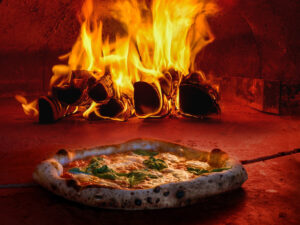
1. Traditional Wood-Fired Oven
This method uses high temperatures and wood to give pizza a unique flavor.

2. Baking Stone
This portable surface, often ceramic, replicates the effects of brick ovens, producing a crispy crust. Metal pizza stone conducts heat efficiently, but direct baking on metal can burn the crust.

3. Grilling
Baked directly on a barbecue grill.
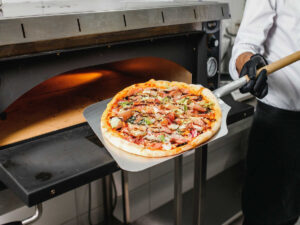
4. Restaurant Ovens
Traditional wood or coal-fired brick ovens, electric deck ovens, conveyor belt ovens, and ovens with fire bricks above the heat source are all methods restaurants often use to bake pizza.

5. Home Baking
Pizzas can be baked on pizza stones in regular ovens or in outdoor wood-fired pizza ovens.
It’s essential to note that the baking method can significantly influence the texture, flavor, and overall quality of the pizza. Plus, different shapes, sizes, and crust thicknesses also require different cooking methods or temperatures.
What Are Pizza Shapes, Sizes, and Thicknesses?
The variety of pizza’s shapes, sizes, and thicknesses offer a distinctive dining experience. Here are some common characteristics with details.
Shapes
There are 2 main shapes: Round and Rectangular versions.

Round pizza
Pizzas with a circular shape are the most common style (e.g., Neapolitan style or most varieties).

Rectangular pizza
They come in rectangular-shaped crusts (e.g., Sicilian pizza, pizza al taglio, Detroit-style pizza).
Sizes
Pizza size varies based on personal needs, including:
Personal or individual
Around 8 inches in diameter.
Small
Around 10 inches in diameter (about 6 slices).
Medium
Around 12 inches in diameter (about 8 slices).
Large
Around 14-16 inches in diameter (about 10-12 slices).
Extra large
Around 16-18 inches in diameter (at least 12 slices).
Sheet or party size
They are normally large with rectangular shapes, meant to serve many people.
Thicknesses
It is measured based on the crust thickness with 3 major types:
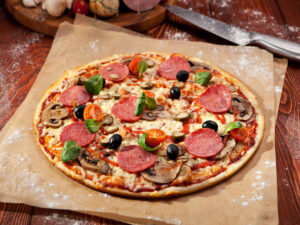
Thin crust
These crusts range from 1/4 inch or less in thickness, offering a light and crispy texture (e.g., Margherita, Neapolitan, New-York style, or California-style pizza).

Thick crust
It is often referred to as “deep-dish” or “pan pizza” with the thickness ranging from 1/88 to 1/4 inch (e.g., Chicago-style, Detroit-style, Colorado-style, or Sicilian variations).

Stuffed crust
This is typically a hand-tossed or thicker crust where the outer rim is stuffed with cheese or other fillings (e.g., cheese-stuffed, pepperoni-stuffed, bacon-stuffed crust).
The diversity in crust types, be it thin, thick, or stuffed, underscores the intricacy and versatility of baking pizzas.
What Are the Varieties and Styles of Pizza?
Below are 27 famous pizza varieties and styles worldwide, including both traditional and modern pizzas. In a general sense, traditional pizzas refer to those that have been made for centuries and have origins in specific regions, especially in Italy. In contrast, modern pizzas are newer creations that have evolved with global influences, fusion cuisines, and contemporary tastes.
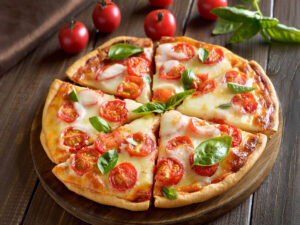
Pizza Margherita
Thin crust. Cooked in a wood-fired oven. Its colors represent the Italian flag
Origin:
Italy
Key Ingredients (Including Pizza Dough):
Pizza dough, San Marzano tomatoes, mozzarella cheese, basil, olive oil

Neapolitan Pizza
Thin crust, simple ingredients, cooked in the wood-fired oven
Origin:
Italy
Key Ingredients (Including Pizza Dough):
Tomato, mozzarella, and a bit of basil

Pizza Quattro Formaggi
Rich and creamy due to the blend of four kinds of cheese, often with a thin to medium crust.
Origin:
Italy
Key Ingredients (Including Pizza Dough):
Pizza dough, tomato sauce (optional), cheese (usually mozzarella, gorgonzola, fontina, and parmesan)

Pizza Quattro Stagioni
Toppings are divided into four sections, representing four seasons of the year
Origin:
Italy
Key Ingredients (Including Pizza Dough):
Pizza dough, artichokes, tomatoes, bell peppers, basil, mushrooms, ham or prosciutto, olives

Pizza Capricciosa
Similar to Quattro Stagioni with 4 types of topping, but they are arranged mixed
Origin:
Italy
Key Ingredients (Including Pizza Dough):
Pizza dough, mozzarella, ham, mushrooms, artichokes, tomatoes, olives

Pizza Marinara
No cheese, thin crust, cooked in a wood-fired oven
Origin:
Italy
Key Ingredients (Including Pizza Dough):
Pizza dough, tomatoes, olive oil, oregano, garlic

Pizza Pugliese
Features ingredients common to the Puglia (aka Apulia) region.
Origin:
Apulia, Italy
Key Ingredients (Including Pizza Dough):
Tomatoes, onions, mozzarella, olives, capers

St. Louis-style Pizza
Cracker-like crust, cut into squares
Origin:
United States
Key Ingredients (Including Pizza Dough):
Pizza dough, tomato sauce, Provel cheese
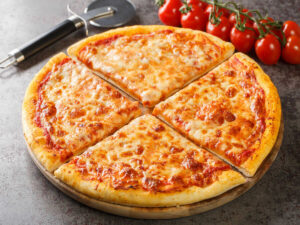
New York-style Pizza
Large hand-tossed thin crust, soft and pliable, often folded in half to eat
Origin:
New York City, USA
Key Ingredients (Including Pizza Dough):
Tomato sauce, mozzarella
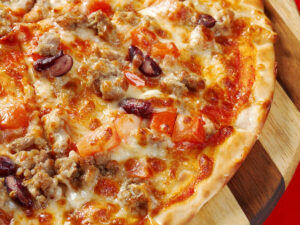
New Haven-style Pizza
Thin crust, charred in a coal-fired oven; known as “apizza”
Origin:
New Haven, Connecticut, USA
Key Ingredients (Including Pizza Dough):
Tomato sauce, pecorino romano cheese
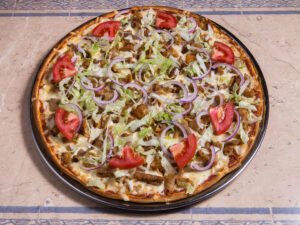
Kebab Pizza
Fusion of Middle Eastern kebab and Italian pizza
Origin:
Sweden
Key Ingredients (Including Pizza Dough):
Pizza dough, tomato sauce, cheese, kebab meat, onions, kebab sauce

Seafood Pizza
Can use either fresh or canned seafood
Origin:
Various
Key Ingredients (Including Pizza Dough):
Various seafood (shrimp, calamari, clams, mussels)

Taco Pizza
Fusion of taco ingredients and pizza
Origin:
USA
Key Ingredients (Including Pizza Dough):
Seasoned meat, cheese, lettuce, tomatoes, taco sauce
Obviously, different pizza varieties can go with different side orders, but there are certain food items that can pair well with pizza.
What Are Other Regional Pizza Varieties in Italy?
Check the table below for key ingredients, characteristics, and origin of 4 other regional Italian pizzas.
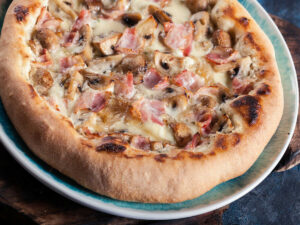
Pizza Bianca
No tomato sauce
Origin:
Various
Key Ingredients (Including Pizza Dough):
Pizza dough, olive oil, garlic, herbs, cheese, toppings, white sauce.

Roman Pizza
Available in two styles: pizza rustica or pizza al taglio (cooked in long, rectangular baking pans and relatively thick) and traditional round shape pizza (thin, crisp base).
Origin:
Lazio (Rome)
Key Ingredients (Including Pizza Dough):
Varies by type (e.g., tomato, mozzarella, anchovies, oil for pizza napoletana in Rome)
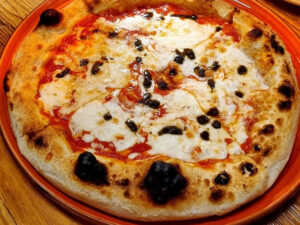
Pisan Pizza
Smaller, thicker pizza. Slices traditionally served folded with a slice of cecina
Origin:
Tuscany (Pisa)
Key Ingredients (Including Pizza Dough):
Anchovies, capers, grated grana padano cheese, cecina (chickpea cake)
Outside Italy, there are countless pizza variations in other cuisines around the world, adapting local ingredients with distinctive features.
What Are Pizza’s Characteristics Around The World?
Now, you’ll have a closer look at pizza features around the world, especially in 6 major regions: Europe, Asia, North America, South America, Oceania, and Africa. Let’s begin with the European countries.
In Europe
European pizza is a tapestry of flavors and traditions. Each country, including Italy, Hungary, Iceland, Malta, Norway, Poland, Russia, Sweden, the UK and Ireland, and Ukraine, adds its distinct features shown in the following table.
| Country | Typical Characteristics |
|---|---|
| Italy | The origin of pizza. Traditionally wood-firing in a stone oven. Offer many variants, from traditional to regional versions. Traditional Italian pizza specifying permissible ingredients and methods |
| Hungary | Traditional toppings: bacon, kolbász (Hungarian sausage, salami, hot peppers, and red onion. Popular brands: Don Pepe, Il Treno, Pizza King, and Pizza Forte |
| Iceland | Use traditional American and Italian style pizza toppings. Sweet topping: banana |
| Malta | Traditional Maltese pizza: Maltese ftira covered in cheese, onions, and potatoes |
| Norway | Prefer both freshly-made and frozen pizzas. Popular frozen pizza brand: Grandiosa. |
| Poland | Popular toppings: ham, salami, mushrooms, onions, bacon Preferred sauce: Garlic dipping sauce |
| Russia | Also use high-class ingredients like salmon, caviar, beef filets, truffles |
| Sweden | Thicker than Neapolitan version with a more spiced sauce. Use Swedish hard cheese instead of mozzarella or dried oregano in place of fresh basil. Popular varieties: Margherita, Capricciosa, Quattro Stagioni, kebab pizzas. |
| UK & Ireland | Popular toppings: Bacon, cheddar, sweetcorn. Common varieties: Italian, American, mass-processed pizzas. Popular brands: PizzaExpress, Strada, Prezzo, Domino’s, Pizza Hut, and Papa John’s |
| Ukraine | Common varieties: Kozatska, Selyanska, Margherita pizza |
In the next section, let’s discuss the characteristics of Asian-style pizzas.
In Asia
Pizzas in Asia, particularly in South, East, and West regions, showcase diverse adaptations using local flavors. Check the table for more details about their unique features.
| Country | Typical Characteristics |
|---|---|
| China | Include local ingredients like tuna, crab sticks, corn, and soy sauce. Popular brands: Pizza Hut |
| India | Many versions feature chicken tikka and paneer. More choices for vegetarian pizzas. Spicier in flavor. Popular brands: U.S. Pizza, Domino’s, Pizza Corner, Smokin’ Joes, |
| Indonesia | Include toppings like satay, balado, and rendang. Popular varieties: Meat Lover’s with pepperoni, tuna with melted cheese, beef black pepper. Popular brands: Pizza Hut, Domino’s, Papa Ron’s |
| Israel | Large portions of vegetable toppings; unusual toppings like corn Have both kosher and non-kosher locations. Popular brands: Pizza Hut, Sbarro |
| Japan | Popular toppings: mayonnaise sauces, squid, corn, potatoes, avocado, eel, or honey, chocolate for dessert pizza. Local crust variants: mochi pizza. Traditional Italian-style pizza is also popular. Popular brands: Pizza-La |
| Korea | Common toppings: bulgogi, dak galbi, corn, potato wedges, sweet potato, shrimp, crab. Popular brands: Domino’s, Pizza Hut, Papa John’s, Mr. Pizza, Pizza Etang |
| Malaysia | Popular brands: Domino’s, Pizza Hut, US Pizza, Papa John’s, D’italiane, Canadian 2 and 1 pizza, Jom Pizza, Sure Pizza |
| Nepal | Common types: paneer pizza, mushroom pizza, chicken pizza. Popular in urban areas, especially Kathmandu |
| Pakistan | Common types: Supreme pizza, chicken tikka, spicy chicken, and sausage-based pizzas. Popular in eastern regions: Sindh, Punjab, Azad Kashmir, Gilgit-Baltistan |
| Philippines | Filipino-style pizza is similar to Hawaiian but thinner and sweeter. Traditional Filipino-style toppings: sardines, dried tinapa, bagnet, longganisa |
| Thailand | Common ingredients: tofu, bean sprouts, shredded carrots, basil, cilantro, shredded green beans, scallion. Popular brands: The Pizza Company |
| Turkey | Common toppings: minced beef, cheeses (like Kaşar and Beyaz), spicy Sucuk sausage, cured meats (like Pastırma), herbs, and olives. Pork products are usually substituted with beef, chicken, or lamb. Popular brands: Pizza Max (local), Pizza Hut, Domino’s, Little Caesars, and Sbarro |
Let’s travel to North America to explore the distinct features of their pizzas.
In North America
North American pizzas, spanning from Canada and the USA to Mexico, are also influenced by local culinary culture and ingredients. Keep reading to find out!
| Country | Typical Characteristics |
|---|---|
| Canada | Distinctive regional variations and types of pizza influenced by local Canadian cuisine (famous variety: Hawaiian pizza). Have both national and regional pizza chain |
| Mexico | Common toppings: jalapeño pepper slices, chorizo, onions, bell peppers, chili pepper, tomato, avocado, shrimp, beef, tripas, tuna, scallops. Popular cheese: Pepper jack cheese or Oaxaca cheese |
| United States | Notable styles: Chicago deep-dish, New York–style, New Haven–style, Detroit-style, jumbo slice. Popular brands: Pizza Hut, Papa John’s, Domino’s |
Besides North America, pizzas in South America are also worth taking a look at.
In South America
South American pizzas, particularly in Argentina, Brazil, Colombia, and Uruguay, feature regional twists, which are discussed below.
| Country | Typical Characteristics |
|---|---|
| Argentina | Have a thicker crust and more cheese. Well-loved varieties: fugazzeta, fugazza with cheese, and pizza a la napolitana. |
| Brazil | Varied toppings, including requeijão (creamy white cheese), chicken or beef, corn, and peas. Sweet pizzas: chocolate or banana. Popular varieties: calabresa pizza, shredded chicken with requeijão, and pizzas with stuffed crusts. |
| Colombia | Popular variety: Hawaiian pizza |
| Uruguay | Have medium-thick crust, rectangular, cooked in a clay oven. Common toppings: ham, mussels, shrimps, olives, peppers, mushrooms, palm hearts, pancetta. Popular varieties: pizza por metro (by the meter), pizza a la parrilla (grilled), pizza rellena (stuffed). |
Now, let’s move to another continent, which is Oceania, to see how locals create their pizzas.
In Oceania
Oceania, including Australia, Fiji, and New Zealand, reflect either international pizzas or local innovative creations. Here are some short overviews about them.
| Country | Typical Characteristics |
|---|---|
| Australia | Offer both Italian and U.S. styles of pizza. Popular with seafood pizzas, especially with prawns. Unconventional toppings: kangaroo meat, emu, and crocodile. Common sauces: barbecue sauce and traditional tomato sauce |
| Fiji | Local variety: chicken pizza. Offer many local pizzerias. |
| New Zealand | Offers Italian varieties or Turkish style pizzas (in Middle-Eastern bakeries and kebab shops). No strict rules for pizza construction. Popular brands: Hell Pizza, Pizza Hut, Domino’s. |
Finally, have you ever wondered what pizza’s features are in Africa? The next section will give you the answer that you’re looking for.
In Africa
While Africa isn’t widely recognized for its pizza consumption, Algeria has its unique approach to crafting pizzas, as detailed below.
| Country | Typical Characteristics |
|---|---|
| Algeria | Traditional pizza with semolina dough, tomato sauce, black olives, and parsley |
Obviously, different pizza varieties can go with different side orders, but there are certain food items that can pair well with pizza.
What Are Accompaniments of Pizza?
There are many possible accompaniments to pair with pizza, but below are the 4 most popular ones:
Chicken wings
Pizza and wings are the perfect duo, as chicken wings offer a meaty side to pizza.
Salads
A fresh salad with light vinaigrette balances the pizza’s heaviness.
Dips
Pizza dip is invented especially for eating the crust.
For example: marinara sauce. The garlic dipping sauce is also a well-loved choice for pizza lovers.
Drinks
Beer’s carbonation and bitterness offset cheese’s richness.
Red wines like Chianti or Merlot pair with tomato-based pizzas.
Pinot Grigio or Sauvignon Blanc suit seafood or white-sauce pizzas.
In casual settings, carbonated soft drinks (or soda), iced tea, and water are common choices.
These pairings shed light on the diverse advantages and drawbacks of pizza as a central dish.
Pros and Cons of Eating Pizza
There are both positive and negative sides to consuming pizza, but they are generally equal. Here are four concerning pros and cons shown below:
Pros
Cons
Now, keep reading to see some frequent questions and answers about pizza.




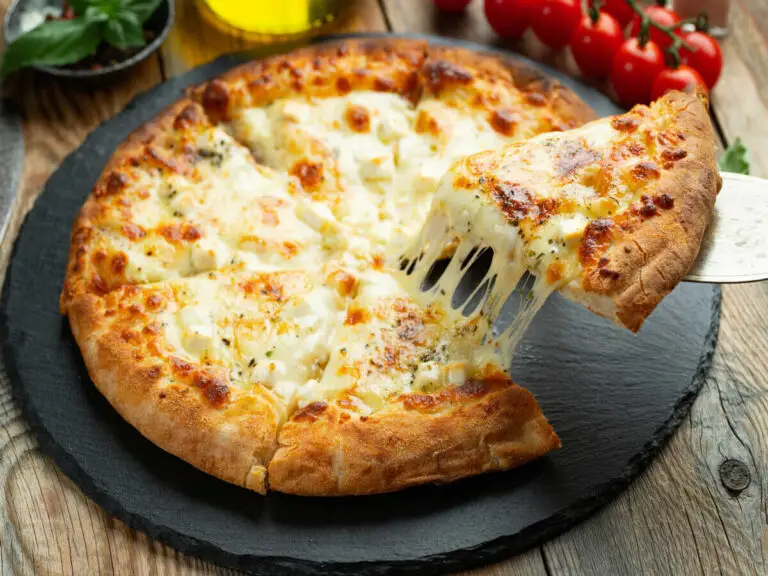
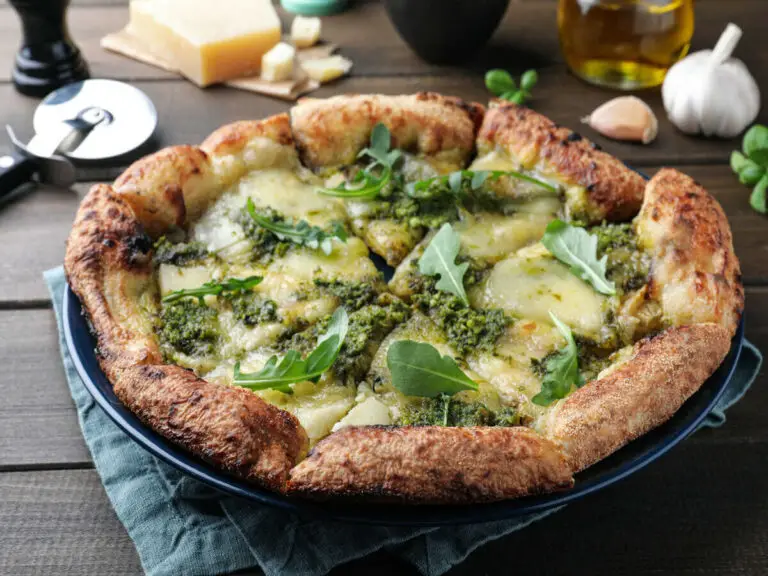
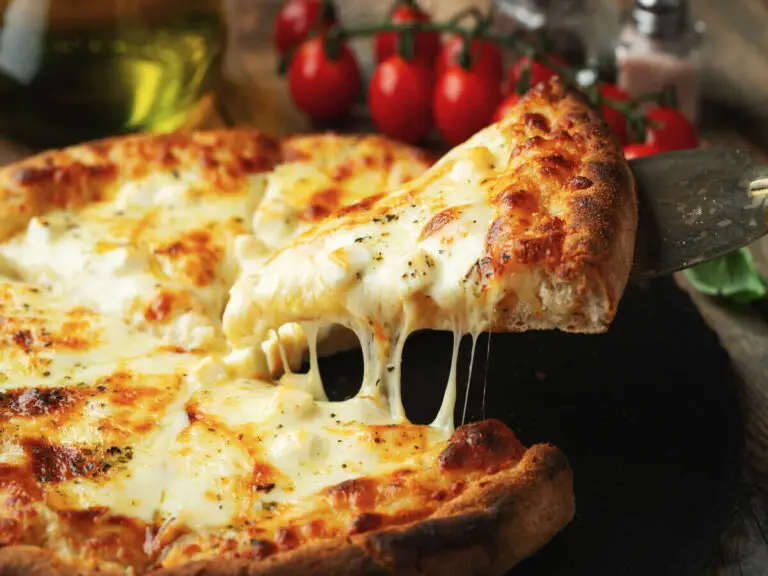
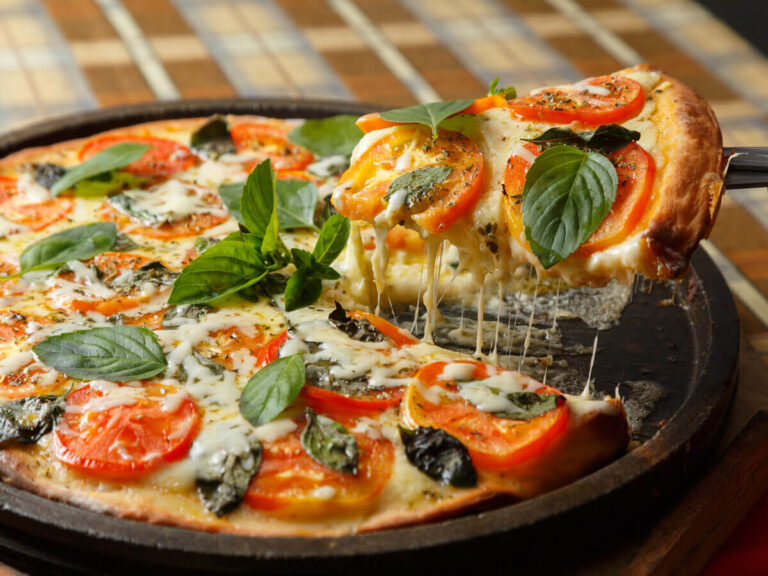
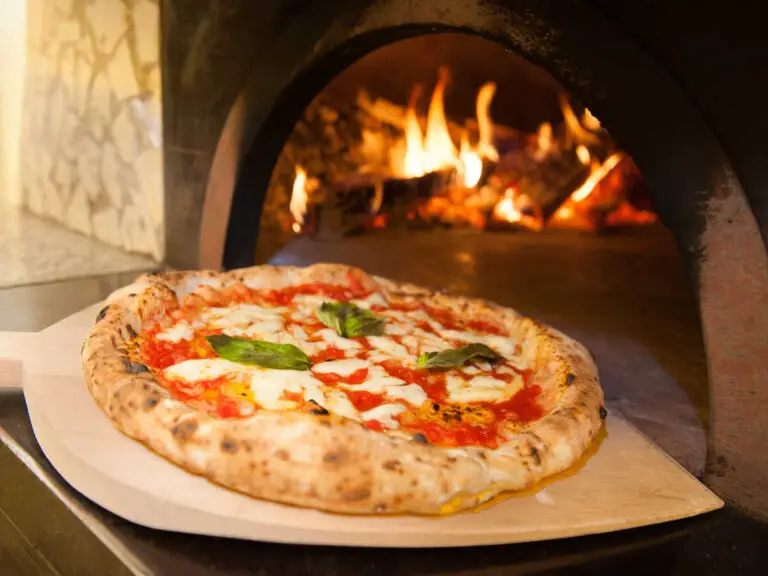

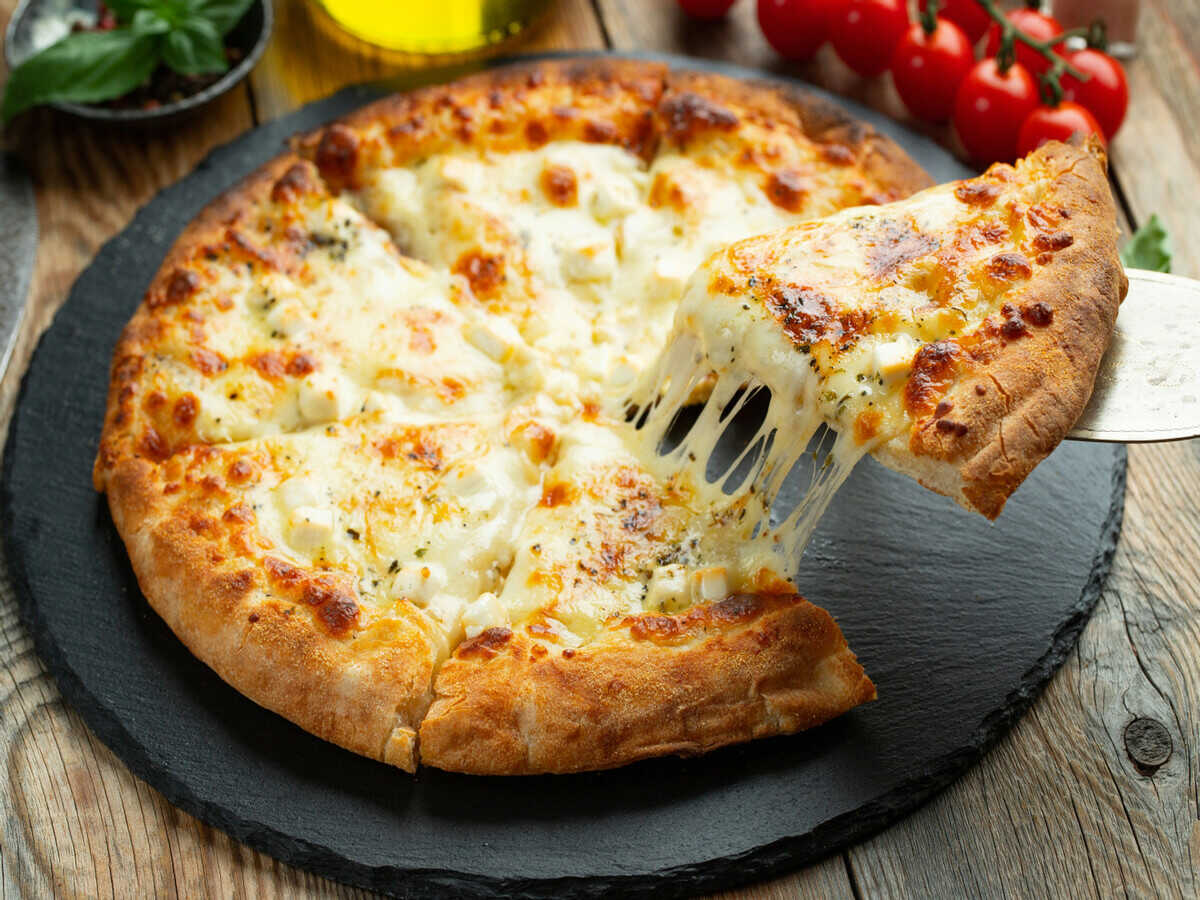
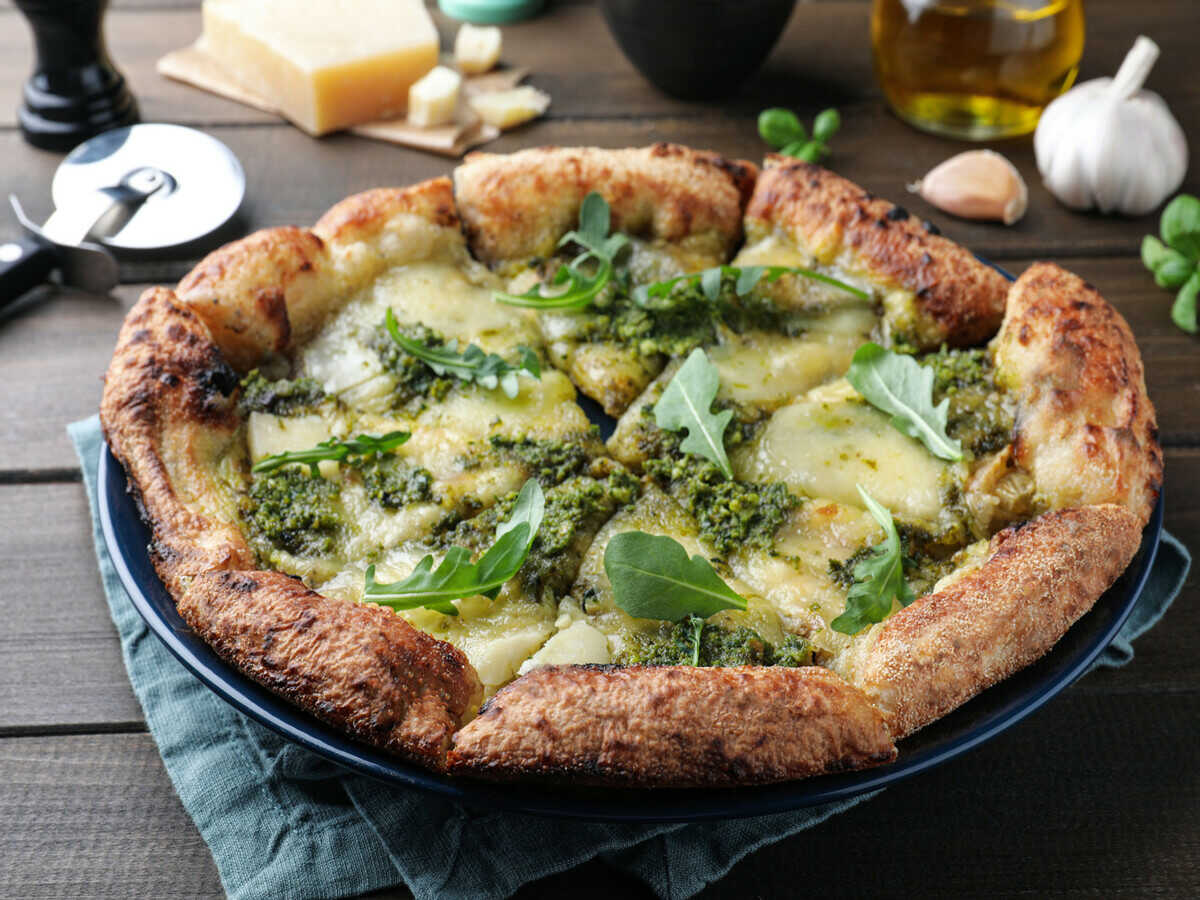
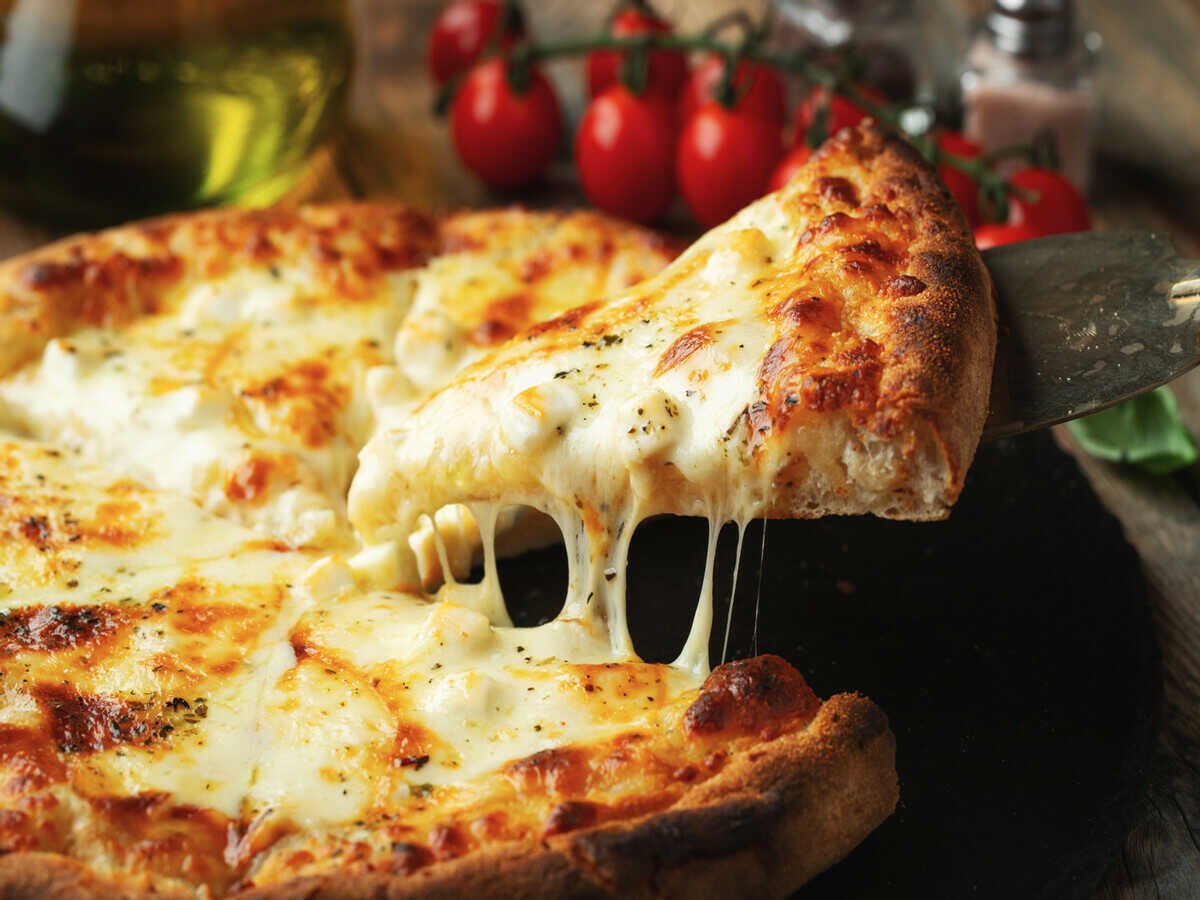

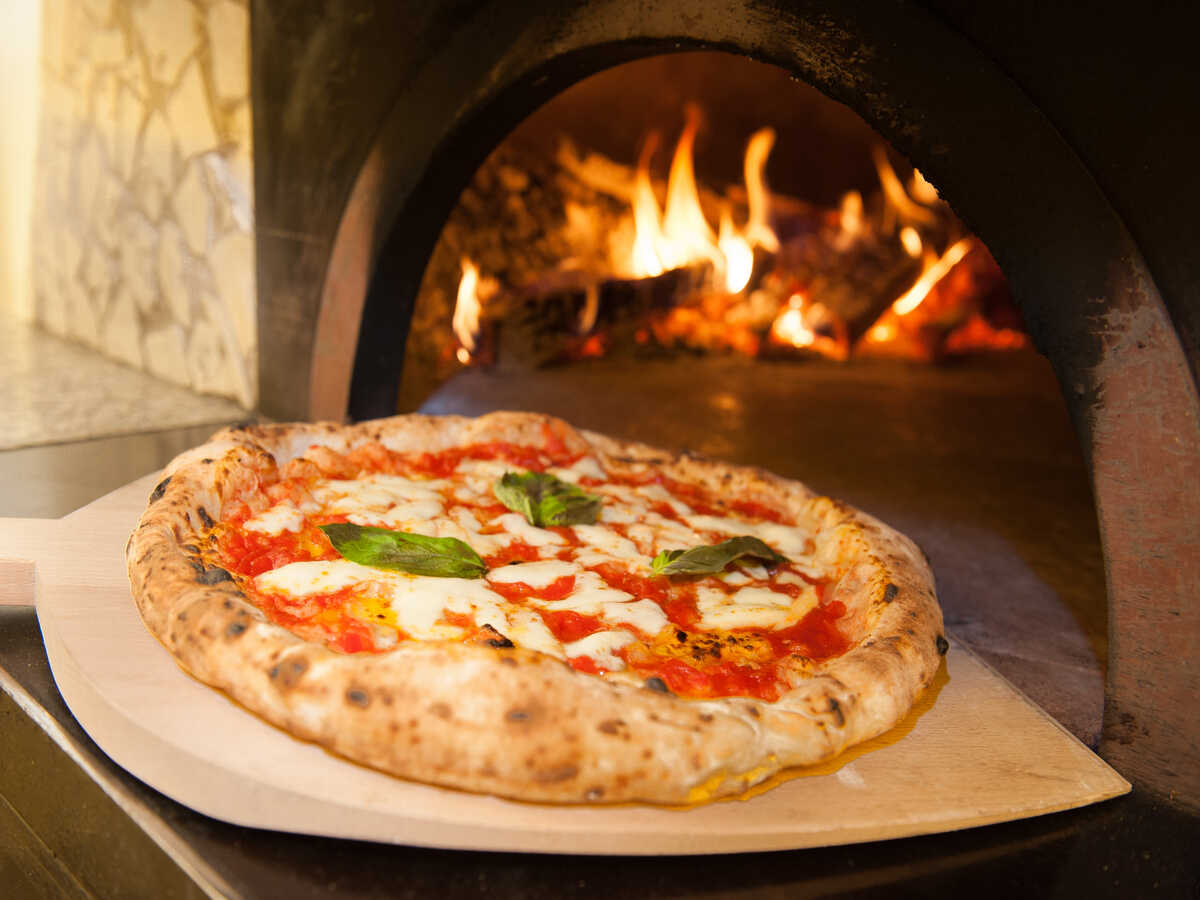



Adam Sam
Senior Food and Drink Editor
Expertise
Food Writer & Recipe Developer, Recipe Tester, Bartender, Cooking-video Maker, Editor In Chief
Education
Adam Sam, an experienced food writer and recipe developer, is passionate about blending diverse culinary traditions, national dishes, and innovative beverages, showcasing his proficiency in both traditional and modern recipe testing.
As the Editor-in-Chief, he elevates culinary content from street food to fine dining, focusing on Western cuisine and types of drinks at azcuisines.com, and is professional in creating engaging cooking videos that simplify complex dishes and ingredients.
His passion for food is evident in his writing, where he uniquely merges various cultures, traditions, and contemporary trends, skillfully combining classic recipes with modern cooking methods.